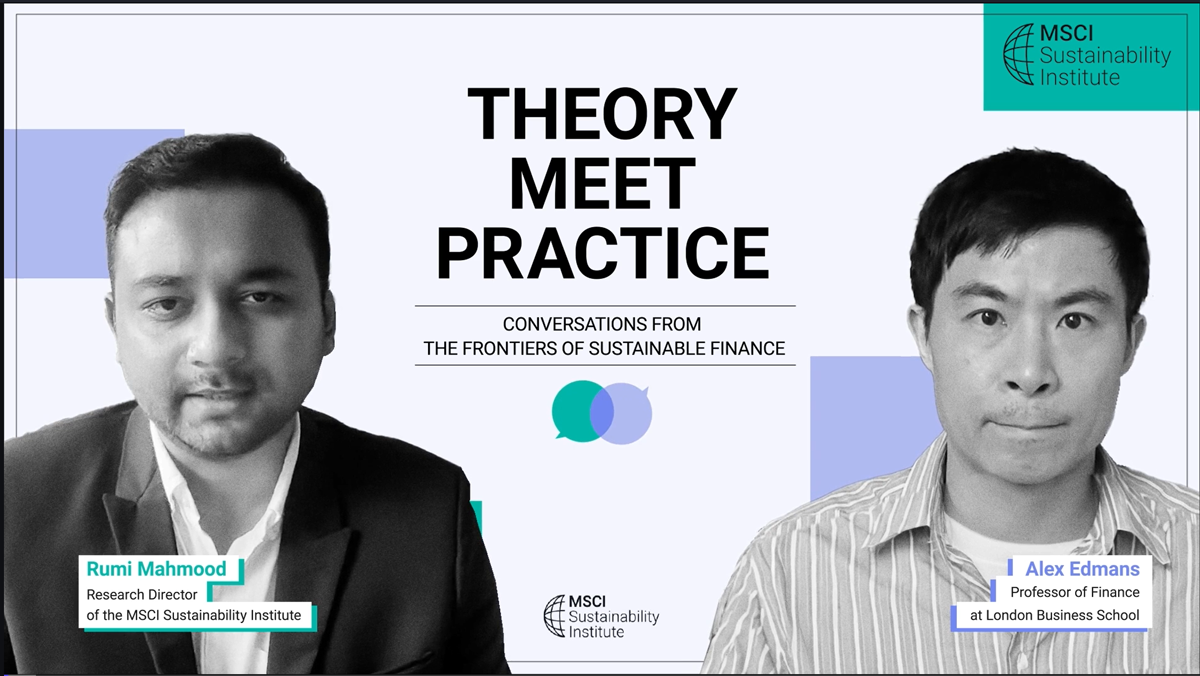Episode 1: MIT’s Roberto Rigobon on making sense of sustainability ratings
We sit down with Roberto Rigobon, Society of Sloan Fellows Professor of Management and a professor of applied economics at the MIT Sloan School of Management. “Aggregate Confusion: The Divergence of ESG Ratings,” the 2022 paper that he co-authored with colleagues Florian Berg and Julian Kölbel, ranks among our favorite papers because of its resonance with practitioners. Professor Rigobon walks us through the drivers of divergence in sustainability ratings and shares his thinking about its significance for practitioners. He discusses the need for innovation and the importance of transparency, as well as a paper on sustainable investing that he would want on a desert island. We also get a peak into his thinking about why rating sustainability is less like rating creditworthiness and more like rating candy.
Measuring companies’ exposure to financially relevant sustainability risks may be a lot more like rating snacks than rating the creditworthiness of companies.
So suggests Roberto Rigobon, the Society of Sloan Fellows Professor of Management and a professor of applied economics at the MIT Sloan School of Management, whom I interview for “Theory Meet Practice,” a new series at the MSCI Sustainability Institute that explores the lessons investors can take from academic research on sustainable finance.
Professor Rigobon should know. He is a co-author of “Aggregate Confusion: The Divergence of ESG Ratings,” which was published in 2022 and won the 2023 Pagano and Zechner Prize for the best non-investment paper published in the Review of Finance, the journal of the European Finance Association.
Rating snacks (think chocolate, almonds, potato chips, goldfish) reflects the unique preferences of the rater – the “yumminess factor,” Rigobon terms it — who actually asks his students at MIT to do exactly that. Not surprisingly, the ratings reflect lots of individual choices.
So too with sustainability ratings, Rigobon explains. “”We want to equate risk assessments across different investors, and that complicates the analysis,” he says. “Different preferences will be reflected in different choices.”
A credit rating, in contrast, measures a company’s ability to pay — difficult to measure, to be sure — but one issue, unlike sustainability risks, which can entail hundreds of issues. “The proliferation of bad behavior that you could in principle have is just tremendously larger, so trying to assess that is an order of magnitude harder,” he notes.
Why ratings differ
As Rigobon sees it, three factors chiefly explain divergence in sustainability ratings. The use of different proxies by ratings providers explains more than half of divergence, he explains, citing how companies treat their workers as an example. In France, he observes, complaints about labor relations tend to be heard by courts, whereas in the U.S., turnover may be a better indicator because workers who feel mistreated by their employer are more likely to quit.
“You would like to have both of these proxies to construct a good measure of labor treatment, but each rating agency is very much looking at their own markets to decide which of these should be used,” he notes.
Differing views of materiality explain most of the rest of the difference. While the treatment of workers may be relevant for nearly every company, a problem such as human trafficking will be more relevant for companies in the clothing business than for a financial firm. “The notion of what is material is very different across the data providers,” he observes, adding that the balance of difference, about 5%, comes from ratings firms weighting issues differently.
“We need a lot of innovation on thinking about how to measure this, and that’s only going to come from competition among data providers,” observes Rigobon, who, snacks aside, likens the challenge of measuring sustainability to measuring inflation, a longstanding subject of his research.
“I am absolutely certain that there’s not one inflation rate for the U.S., there are thousands,” he says.
Nor is there one view of a company among equity analysts, notes Rigobon, who points to the sell-side research that informs investors’ views of companies. When it comes to looking at stocks, “investors are used to a dispersion of opinions, and that dispersion is actually what gives them a fuller set of information,” he notes, adding that divergence in sustainability ratings “might actually be providing more information for investors for use in their investment decisions.”
The usefulness of any sustainability rating ties to transparency, which enables investors to understand the rater’s methodology, Rigobon stresses. “MSCI is super-open and super-transparent, you tend to explain more or less how you compute things, so I can make sense of the dispersion when I look at your rating,” he says.
For more academic papers on sustainable investing that we summarize for investors, visit our Sustainability Research Portal.


